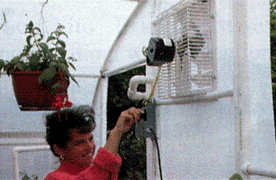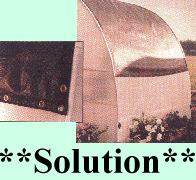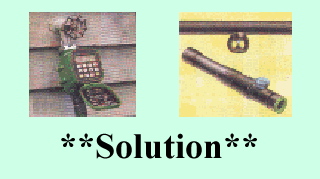|
|
|

GREENHOUSE HVAC CONTROL
Even during cold weather a greenhouse can get too warm on bright, sunny days. So ventilation equipment should be built into your structure to control temperatures in all seasons. If you use hand- operated roof vents, they will require frequent temperature checks. As outdoor weather changes, sashes must be opened and closed manually to keep plants from getting too hot or cold. Automatic ventilation eliminates the manual work and is the best way to cool a greenhouse. As an example, if your structure has roof vents, a special electric motor and thermostat will open and close the vents. Fresh outside air is brought in through the roof vents. Warm air flows out through escape vents. Besides reducing heat, the change of air improves growing conditions.
Responding to this air transfer, the thermostat will turn off and on to keep temperatures right for plants. Fans provide good ventilation and are needed in both large and small greenhouses. Exhaust fans should be large enough to change the air within the structure every minute. To accomplish this, the capacity of the fan in cubic feet per minute at 1/8-inch static pressure should equal the volume of the structure. The volume can be calculated by multiplying the floor area by 7.
If the structure is high enough, place the exhaust fan and the motorized intake louvers above the doors at opposite end-walls. This will exhaust the hottest, most humid air, and prevent a direct draft on the plants near the intake. Fan and duct HVAC can also be used for automatic HVAC. Plastic ducts are suspended by wires or straps from the roof of the structure. The fan-heater-louver unit gives positive air flow and the polyethylene duct distributes the incoming air evenly throughout the house.
SHADING
When protection from the sun is needed, use roll-up screens of wood or aluminum, vinyl plastic shading, or paint-on materials. Roll-up screens are available with pulleys and rot-resistant nylon ropes. These screens can be easily adjusted from outside, as weather and sunlight vary. Vinyl plastic shading is made of a flexible film that reduces light from 55 to 65 percent. The material comes in rolls and installs easily against the glass inside your structure. To apply, just wash the glass with a wet sponge, then smooth the plastic onto the wet glass. When smoothed into position it adheres to the glass. It can be pulled off and used again. Shading compound can also be applied on the outside of the glass. It can be thinned with paint solvents. It usually comes in choices of white or green. Shading compound which mixes with water can also be used.
EVAPORATIVE COOLING
An evaporative cooler (or fan and pad system) eliminates excessive heat and adds beneficial humidity to the structure atmosphere. With an evaporative cooler, moist cool air is circulated throughout the structure. Warm air flows out through roof vents or exhaust fans. Temperature is lowered, humidity is increased, and watering needs are reduced. You can select a cooler of the right size as follows:
• First, calculate the cubic feet of your structure by multiplying the length by the width by the average height.
• Next, add 50 percent to the total cubic space, then select a cooler which has at least this CFM (cubic feet/minute) air capacity rating.
The cooler must be installed outside the structure. If it is inside, it can only humidify and cannot cool. A properly sized cooler will reduce the structure temperature approximately 80 percent of the difference between the outside wet-bulb and dry- bulb thermometer readings. In hot, dry areas this system can reduce the temperature from 30 to 40 degrees. In wet, humid areas the heat reduction will be less. It is most effective during the hottest part of the day.
MIST PROPAGATION CONTROLS
Mist sprays are used in propagating to keep the atmosphere humid. The most popular of 2 types of mist propagation controls is by means of time clocks. The other system controls the cycles by evaporation from a mechanical or electronic leaf or screen.
Time Clock System:
This system of automatic watering includes:
• A dual-time clock consisting of a 24-hour clock and a 6-minute clock.
• An electric water valve with strainer.
• Hose bibbs.
• A toggle switch to give you a choice of manual or automatic operations.
***
Evaporation System
This system provides a special unit that operates within the mist spray from the nozzles. When the stainless steel or ceramic screen and the plants become saturated, the screen tilts to a downward position, which switches off the water. The water evaporates both on the mesh screen and on the cuttings. When the screen loses weight, the screen raises and actuates the switch. This opens the solenoid valve and starts the misting cycle again, according to the needs of the cuttings. Because this control is activated by the weight of the water, it is fully automated and operates continuously day and night.
EXHAUST FAN CALCULATORS
In order use an exhaust fan calculator
to figure out the appropriate type and size exhaust fan for you, you must
consider the size of your garden area first. The general rule is to have an
exhaust fan that will completely exhaust the garden area in less than 5 minutes.
This is how...
Let's figure out the cubic feet of your garden area. Measure
the floor of the area (example 3 feet by 4 feet), and multiply this by how tall
the area is (example 8 feet). In this example, you would have 3 times 4 times 8,
which equals 96 cubic feet.
Naturally, if you buy a 96 cubic foot per minute (CFM) fan,
you would be able to exhaust the whole room in one minute.
If you divide this number by 5, you get the smallest CFM
(cubic foot per minute) that you would want to go with. In this example, 96
divided by 5 = 18.24 CFM. An 18.24 cubic foot per minute fan is the smallest fan
you would want to consider.
Now, to get a better idea of your fan needs, you need to look
at your whole exhaust setup. Your light, your fan, and the way you move the air
through the garden area are known together as your exhaust setup.
Other Things to Consider
In reality, there are a number
of things to consider that will affect the actual cubic feet that your garden
exhaust fan will move each minute. These things fall into three categories...
- your air exhaust duct runs
- your light reflector options
- the addition of a carbon filter
The exhaust fan is designed to move air FROM your garden area
TO another area. In order to do that, you normally need to move the air through
air ducts.
The minute you connect an air duct to your exhaust fan, the
amount of air you can move (your CFM) drops. This is because it takes more
energy to blow air through ten feet of air ducts than to just blow the air
straight out the fan.
The longer the air duct run, the more your CFM will drop,
especially if there are bends/turns. Try to keep it under 20 feet.
Your grow light reflector can block your airflow and reduce your CFM. This is critical information for anyone who wants to get started in the right direction.
The above are all good reasons to get an over-sized fan (one
larger than indicated on the exhaust fan calculator).
There are only two types of fan that are appropriate to use as exhaust fans... they are squirrel cage fans and centrifugal fans. Everything you have read up to this point can be accomplished with a squirrel cage fan.
Exhaust Fan Options With a Carbon Filter
If you decide to add a carbon filter, than a squirrel cage
fan is not quite powerful enough to do the job well. You need the kind of air
pressure only one kind of fan can deliver. You need a centrifugal fan. Your
centrifugal fan will both filter your air, cool you lights, AND exhaust your
garden area.
In addition, a centrifugal fan will maintain it's CFM in many situations where a squirrel cage fan will not, so it is not necessary to get an "over-sized" fan. Simply follow whatever CFM the exhaust fan calculator indicates.
Watering Kits for Potted Plants
Watering kits for potted plants can also be used. Water is supplied directly to each plant through hollow plastic tubes, which are permanently attached. One tube can be used for each small pot and 2 or more for larger pots. Water tubes are weighted at the outlet end; each tube is approximately 5 feet long, and can be cut to shorter length if necessary.
***
To Learn More About Planning, Select Your Area of Interest by 'Clicking' on the Index Text Below
TYPES OF GREENHOUSES & CONSTRUCTION
GREENHOUSE BASIC DESIGN & LOCATION
COLD FRAMES, HOTBEDS & PROPAGATING FRAMES
GREENHOUSE LIGHTING, TEMPERATURE AND CONTROL
|
Copyright 2006, All Rights Reserved Including Page and Website "Look & Feel" |

"A Company with Products & Services to Enrich Your World"



